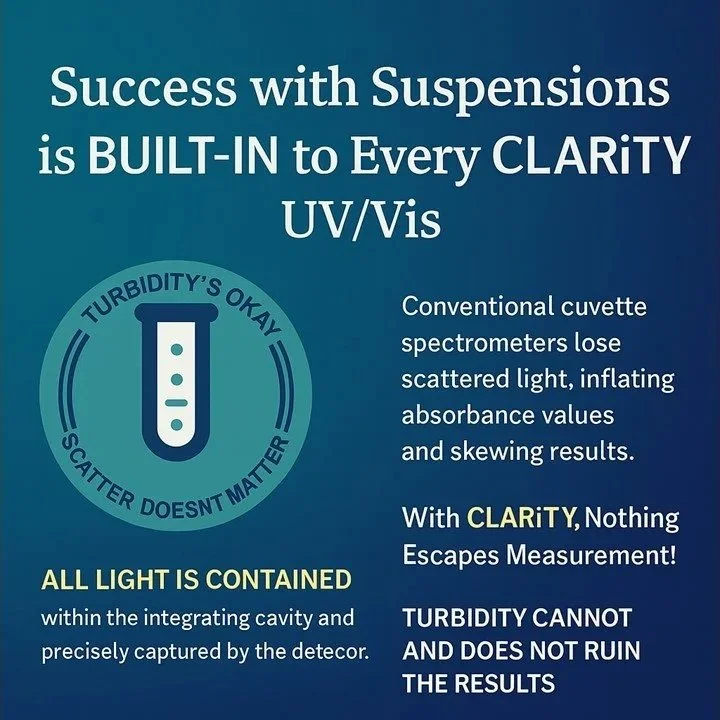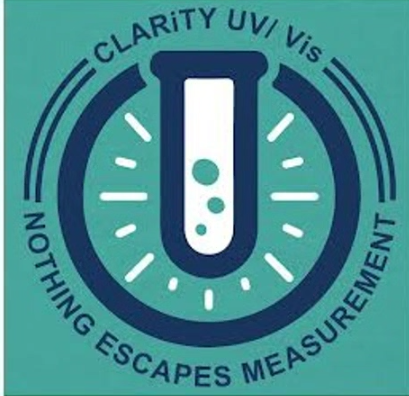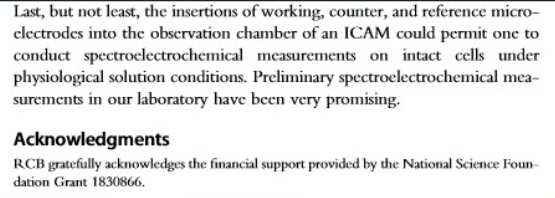
CLARiTY UV/Vis Spectrophotometers
Make the best and most meaningful UV/Vis measurements of your career.
Or stay limited by technology you choose to use.
Scatter ruins a million UV/Vis experiments. It ruins them by limiting you to solution studies rather than whole cell, nanoparticle suspension, or other ‘real’ samples. This has been a reality since the earliest days of UV/Vis spectroscopy. And the need for clear solution samples has created quite a market for sample purification/ filtration/ centrifugation/ clarification products. How much talent and material are expended to get samples clear enough for good results from a cuvette spectrophotometer?
We hate this problem. And we hate that there are still people in 2025 who think this is the only way to do UV/Vis absorbance spectroscopy. We feel for you! How much time and money have you poured into this man-made problem? Why hasn’t someone created UV/Vis spectrophotometers which don’t care whether the sample is clear or turbid?
Thankfully, back in the 2010’s, our company did.
And over the years, we have expanded the models to fit nearly all of the million measurements in need. At the top of the performance and price point is the CLARiTY 1000 that was our first model. Its phenomenal performance includes real-time capture of the electron transport chain from intact living cells! We also have non-rapid-scanning models. And a few years ago, we added a full line of single application models for protein concentration at 280 nm, beverage color at 430 nm, and many more.
When you are no longer limited to clear solution studies, you’ll be liberated to measure the most samples of greatest value to you. You’ll be liberated from minutes, hours, months, of sample preparation. You’ll eliminate the expense associated with sample purification/ clarification/ etc. You’ll be making potentially the best and most meaningful UV/Vis measurements of your career. When scatter does not matter, those million experiments are now available to you. Successfully. Or stay limited by technology you choose to use.
Comparing the CLARiTY vs Cuvette UV/Vis
Notice the Y-axis as well as the structural difference. The identical sample was used in both readings.
Experiment conducted by Prof S. Bailey-Hartsel using a CLARiTY 17 at UMN.
CLARiTY: Permitting you to Measure Where it Matters the Most, in Solution & Suspension.
-

OLIS CLARiTY VF
The perfect instrument for many sample types: organic, inorganic, biological, materials, and more.
Factory configured for UV, Vis, or both
Specify absorbance or fluorescence configuration, which can be changed between measurements
-

OLIS CLARiTY 1000
Do you have dreams of understanding metabolism & other kinetic studies within whole cells, living tissue, and more?
This is the spectrophotometer you would have designed.
Up to 100 scans per second over 50, 230, or 500 nm span
Brilliant light throughput with highest sensitivity 240-800 nm, easily covering the entire electron transport region and more.
Easily converts for stopped-flow spectroscopy (becoming an OLIS RSM 1000)
-

OLIS CLARiTY 17
You want both the best of dual beam measurements for solutions, 185-2600 nm, and suspensions, 240-800 nm
Built upon an upcycled Cary 14/17, yours or ours
Angstrom resolution & immeasurably low stray light
Practical to repurpose as an OLIS DSM 17 CD and MCD, (see OLIS DSM 17)
-

OLIS CLARiTY 245
Ideal for live cells to nanoparticles
High-performance scanning Uv/Vis spectrophotometer which is equally an absorbance and fluorescence system.
240-800 nm
Convertible to UV/Vis circular dichroism and CPL (OLIS DSM 245)
-

OLIS CLARiTY 1, 2, 3
CLARiTY in a tiny package for exactly those 1, 2, or 3 wavelengths you need.
Answer is returned in 4 seconds
Clarifying the sample is 100% optional
Application specific for protein concentration (IC280), beverage color (IC430), and more
-

Which CLARiTY should you choose?
“Obtaining absorbance spectra from turbid retinal cell and tissue suspensions”
From this powerful article, a few lines: “Although a powerful analytical tool, spectroscopy is often limited by the nature of the specimen. Spectroscopy typically requires samples to be transparent solutions free of insoluble material, which through light scatter, diffuse the incoming light beam. …spectroscopy works wonderfully in many areas of biochemistry, [but] such specimen requirements are frequently not possible in cellular or tissue physiological chemistry [where] molecules work within intracellular, extracellular, or membrane environments.”
CLARiTY: Freedom from the limitation of cuvettes, expanding your choices from sample volume and concentration to solvents.
Visit our Experiments & https://olisclarity.com/research to see more applications
The CLARiTY Advantage
Integrating Cavity Spectrophotometers For a Powerful New Generation of Measurements
Everyone knows about spectrophotometers that use cuvettes. With cuvette spectrophotometers, accurate results are possible only with perfectly clear samples. When the sample is hazy or turbid, the light beam carrying the absorbance information is scattered, much of it away from the detector. The answer is therefore higher absorbance than is correct.
The Short and Long of It.
The Short
A single page piece, circa 2014, on using CLARiTY to follow metabolism in the electron transport chain:
“Today, research using a new integrating cavity spectrometer has demonstrated that isolated cell components do not act the same as when those components are in their native environment … when they are not in the environment in which they were designed to function, they may behave differently.”
The Long
A 16 page chapter, circa 2020, on using CLARiTY:
“One thing is certain: one way to understand how a protein functions in an intact organism is to actually observe that protein as it functions in the intact organism. This paper provides an example of just such an observation.”
Having fun demonstrating an early version of a CLARiTY system:
CLARiTY F.A.Q.s
Are the results from a cuvette and the CLARiTY integrating cavity the same?
Yes, if there is zero scatter from the sample, both methods return the same results.
No, if the sample scatters light, CLARiTY returns the correct absorbance, while a cuvette system returns extinction.
I don’t want to dilute my sample. What’s the alternative?
Reduce the pathlength, as you would with a traditional cuvette spectrophotometer. CLARiTY instruments can be fitted with integrating cavities of various volumes, from the standard 8 mL to a few microliters. Shorter pathlengths require more concentrated samples.
What is the dynamic range for measuring absorbance?
Approximately 10⁻⁴ AU/cm with the 8 mL integrating cavity and 100 AU/cm with the 0.08 mL flow-through integrating cavity.
Should I use the filled DSPC, a test tube, or a flow-through cell with CLARiTY?
Filled DSPC (8 mL cavity): Provides the longest pathlength for the highest sensitivity. Test Tubes: Suitable for shorter pathlengths and handling toxic or difficult-to-clean samples. Flow-Through DSPC: Used for highly absorbing samples (e.g., wine, milk) and continuous process monitoring with a pump.
How do I clean CLARiTY’s integrating cavity between measurements?
Filled DSPC: Pipette out the sample, rinse with water/solvent, then rinse with fresh solvent. Test Tubes: Pour out the sample, rinse with water/solvent, clean as needed, and store inverted. Flow-Through DSPC: Flush with water or solvent, clean as needed, and finish with a final rinse
You achieve a beginner’s mind by dropping all expectations and preconceived ideas—shutting off autopilot—and seeing things with an open mind and fresh eyes—like a beginner, like a child.
Beginner’s mind or Shoshin has proven to be a great tool for my professional, creative, and personal life. I stumbled upon this concept when I was learning to meditate.
An integrating cavity can be thought of as a filled integrating sphere. It was the 1950s when group of oceanographers gave this idea a try. Their goal was to achieve a very long pathlength and thus very high sensitivity.













